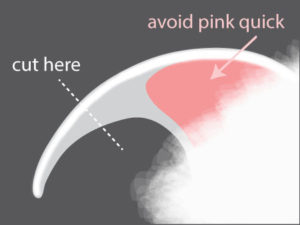Video
Ever Wonder how to safely trim cat nails? Dr. Cuesta demonstrates - starring Chopstick!
Chopstick is one of the Cuesta family's four adopted cats. Chopstick was brought to the animal hospital in a box full of tiny, dirty, sickly kittens. All of the kitten found homes, including Chopstick's sister, Sushi, who was also adopted by the Cuesta family. Chopstick grew into a big, healthy cat and he will be celebrating his 17th birthday this year!
If the names of Chopstick and Sushi remind you of a delicious night out, you're not alone! We think food names also make very good pet names. A few cool cats we know are named WonTon and KimChee. Cute names indeed!
Diagram
 Your cat's claws are made of two basic parts. The pink part nearest the nail bed is living tissue called the "quick." The clear part is the nail area that is safe to cut, just like your nails. See the diagram above and compare it with your cat's claws. The dashed line shows where it is safe to cut.
Your cat's claws are made of two basic parts. The pink part nearest the nail bed is living tissue called the "quick." The clear part is the nail area that is safe to cut, just like your nails. See the diagram above and compare it with your cat's claws. The dashed line shows where it is safe to cut.
Aim to nip off just the sharp tips of the nail. Avoid cutting near anything pink! That is the quick, and if you nip it, you will surely know about it. The nail will bleed, and your cat has probably already bolted. To avoid feline freak-outs, trim nails often. The more you trim kitty's nails, the more he or she will get used to it. When they learn that nail trimming doesn't hurt, they may even look forward to the extra attention and petting you will give them!
Most cats will be okay with trims, but some cats simply won't cooperate and must be restrained by professionals for trimming. It is important to keep the nails trimmed so that the nails don't grow too long and become embedded in the paw. This is particularly a concern for long haired cats, where the human caretaker might not see the nail.
If you should have any questions about nail trimming, just ask one of our Pet Nursing staff. They will be happy to demonstrate how to properly trim kitty's nails.
Cat Nail Trimmer Types
There are s everal types of cat trimmers to choose from. When clients ask us which one to use, our best answer is "the one that works!" The scissor type works well for kittens and cats with smaller nails. The guillotine type offers precision for thicker nails, but you have to position the claw inside of the round cutting area. The nipper type is a simple solution that can also be used for other pets.
everal types of cat trimmers to choose from. When clients ask us which one to use, our best answer is "the one that works!" The scissor type works well for kittens and cats with smaller nails. The guillotine type offers precision for thicker nails, but you have to position the claw inside of the round cutting area. The nipper type is a simple solution that can also be used for other pets.
There is also a product called Soft Claws which is marketed as an alternative to declawing for destructive cat scratching. Soft Claws covers the nails in protective plastic, keeping kitty's nails hidden for several weeks. There are many colors to choose from, and they can be comined for holidays such as red & green, or orange& black.

